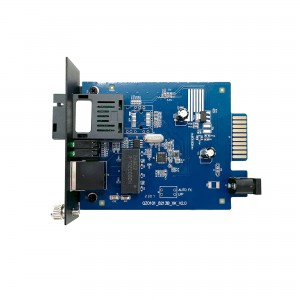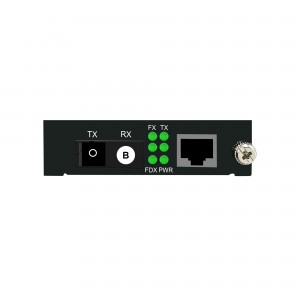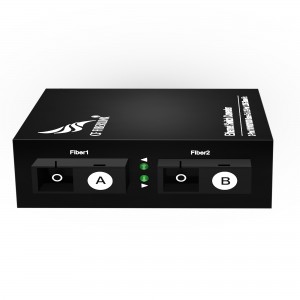10-port 10/100/1000M Media Converter(SFP)
10-port 10/100/1000M Media Converter(SFP)
Product Features:
Gigabit 2 Fiber 8 Cable SFP Introduced: Revolutionizing Industrial Communications
Welcome to Huizhou Changfei Optoelectronics Technology Co., Ltd., a leading manufacturer of cutting-edge industrial communication products and cloud-managed network solutions in China. With a commitment to excellence, our products range from cloud-managed industrial switches to PoE switches, from Ethernet switches to fiber optic transceivers and wireless transmission equipment. We are committed to providing systematic equipment, solutions and overall services to a wider range of users, positioning ourselves as a world-class industrial communication expert.
We are proud to present our latest innovation: Gigabit 2 Fiber 8 Cable SFP. Specifically designed to meet the changing needs of the industrial sector, this exceptional product combines the functionality of an SFP to RJ45 converter, fiber to Ethernet switch, and outdoor fiber media converter into one compact unit. With its advanced features, it provides seamless connectivity and unrivaled data transmission efficiency for various industrial applications.
One of the outstanding features of the Gigabit 2-fiber 8-lane SFP is its low power consumption, making it an environmentally friendly choice without compromising performance. In line with our commitment to sustainability, we have ensured that this product minimizes energy consumption and reduces its carbon footprint. This not only benefits the ecosystem, but also helps businesses strengthen their commitment to a greener future.
Another notable feature is the 4-digit dial, which simplifies the installation process and improves operational efficiency. With just a few quick adjustments, users can easily configure and monitor settings, ensuring seamless integration with existing systems. This user-friendly design simplifies workflow and reduces setup time, ultimately increasing productivity in industrial environments.
Gigabit 2-fiber 8-wire SFP with SC interface ensures stable and reliable connection and excellent data transfer rate. The SC connector design ensures precise alignment of the fiber cores, minimizing signal loss and maximizing network efficiency. This ensures uninterrupted data transmission even in demanding industrial environments, enabling businesses to stay connected and operational at all times.
When it comes to industrial communications, trust and reliability are paramount. At Huizhou Changfei Optoelectronics Technology Co., Ltd., we take pride in providing quality products that meet the stringent requirements of the industrial sector. Our Gigabit 2 Fiber 8 Cable SFPs are no exception. Rigorously tested and engineered to withstand harsh conditions, this product delivers exceptional performance and unmatched durability to ensure seamless, reliable network connections.
Whether you are building a new industrial network or upgrading an existing infrastructure, the Gigabit 2 Optical 8 Cable SFP is the perfect solution. Its versatile design and advanced features allow businesses to optimize operations, simplify communication and increase productivity. With our industry expertise and commitment to customer satisfaction, you can be confident that this product will exceed your expectations and deliver exceptional results.
In summary, the Gigabit 2 Optical 8 Cable SFP is an innovative solution that has revolutionized industrial communications. With its low power consumption, 4-digit dial and SC interface, this product offers unrivaled performance, efficiency and reliability. Combine this with the expertise of an industry-leading force, Huizhou Changfei Optoelectronics Technology Co., Ltd., and you have a win-win combination that drives your business to success. Upgrade your network infrastructure today with the Gigabit 2-Fiber 8-Cable SFP and experience the future of industrial communications.
Technical Parameter:
|
Model |
CF-2008GW-SFP | |
| Interface Characteristics | ||
|
Fixed Port |
8* 10/ 100/ 1000Base-T RJ45 port 2* 1000Base-X uplink SFP fiber port |
|
|
Ethernet Port |
10/ 100/ 1000Base-T auto-sensing, full/half duplex MDI/MDI-X self-adaption |
|
|
Twisted Pair Transmission |
10BASE-T: Cat3,4,5 UTP(≤100 meter) 100BASE-T: Cat5e or later UTP(≤100 meter) 1000BASE-T : Cat5e or later UTP(≤100 meter) |
|
| Optical Port | Gigabit SFP optical fiber interface, default not include optical modules (optional single-mode / multi-mode, single fiber / dual fiber optical module. LC) | |
| Wavelength/Distance | multimode: 850nm 0~550M,1310nm 0~2KM
single mode: 1310nm 0~40KM ,1550nm 0~120KM |
|
| Chip Parameter | ||
| Network Protocol | IEEE802.3 10BASE-T, IEEE802.3i 10Base-T,
IEEE802.3u 100Base-TX, IEEE802.3u 100Base-FX, IEEE802.3x IEEE802.3ab 1000Base-T;IEEE802.3z 1000Base-X; |
|
|
Forwarding Mode |
Store and Forward(Full Wire Speed) |
|
|
Switching Capacity |
20Gbps |
|
|
Buffer Memory |
14.88Mpps | |
|
MAC |
2K | |
|
LED Indicator |
Fiber | FX1 (green)-FX2 (green) |
| Data | 1-8 Green: Indicates network working status | |
| Power | PWR (green) | |
| Power | ||
| Working Voltage |
AC:100-240V |
|
|
Power Consumption |
Standby<3W, Full load<10W |
|
|
Power Supply |
DC:5V/2A industrial power supply |
|
| Lightning protection &Certification | ||
| Lightning protection | Lightning protection: 4KV 8/20us, Protection level: IP30 | |
| Certification | CCC;CE mark, commercial; CE/LVD EN60950;FCC Part 15 Class B; RoHS | |
| Physical Parameter | ||
| Operation TEMP | -20~+55°C;5%~90% RH Non condensing | |
| Storage TEMP |
-40~+85°C;5%~95% RH Non condensing |
|
| Dimension (L*W*H) | 198mm* 92mm*28mm | |
| Installation | Desktop | |
Product Size:
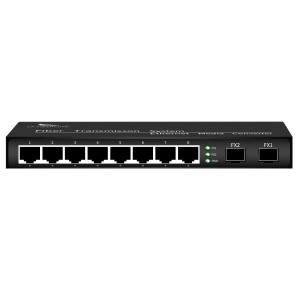
product application diagra:

How to choose a fiber optic transceiver?
Optical fiber transceivers break the 100-meter limitation of Ethernet cables in data transmission. Relying on high-performance switching chips and large-capacity caches, while truly achieving non-blocking transmission and switching performance, they also provide balanced traffic, isolation and conflict. Error detection and other functions ensure high security and stability during data transmission. Therefore, fiber optic transceiver products will still be an indispensable part of actual network construction for a long time. So, how should we choose fiber optic transceivers?
1. Port function test
Mainly test whether each port can work normally in the duplex state of 10Mbps, 100Mbps and half-duplex state. At the same time, it should be tested whether each port can automatically select the highest transmission speed and automatically match the transmission rate of other devices. This test can be included in other tests.
2. Compatibility test
It mainly tests the connection ability between the optical fiber transceiver and other devices compatible with Ethernet and Fast Ethernet (including network card, HUB, Switch, optical network card, and optical switch). The requirement must be able to support the connection of compatible products.
3. Cable connection characteristics
Test the fiber optic transceiver’s ability to support network cables. First, test the connection ability of Category 5 network cables with lengths of 100m and 10m, and test the connection ability of long Category 5 network cables (120m) of different brands. During the test, the optical port of the transceiver is required to have a connection capability of 10Mbps and a rate of 100Mbps, and the highest must be able to connect to a full-duplex 100Mbps without transmission errors. Category 3 twisted pair cables may not be tested. Subtests can be included in other tests.
4. Transmission characteristics (transmission loss rate of data packets of different lengths, transmission speed)
It mainly tests the packet loss rate when the optical fiber transceiver optical port transmits different data packets, and the connection speed under different connection rates. For the packet loss rate, you can use the test software provided by the network card to test the packet loss rate when the packet size is 64, 512, 1518, 128 (optional) and 1000 (optional) bytes under different connection rates. , the number of packet errors, the number of packets sent and received must be more than 2,000,000. Test transmission speed can use perform3, ping and other software.
5. The compatibility of the whole machine to the transmission network protocol
It mainly tests the compatibility of fiber optic transceivers to network protocols, which can be tested in Novell, Windows and other environments. The following low-level network protocols such as TCP/IP, IPX, NETBIOS, DHCP, etc. must be tested, and the protocols that need to be broadcast must be tested. Optical transceivers are required to support these protocols (VLAN, QOS, COS, etc.).
6. Indicator status test
Test whether the status of the indicator light is consistent with the description of the panel and the user manual, and whether it is consistent with the current status of the fiber optic transceiver.









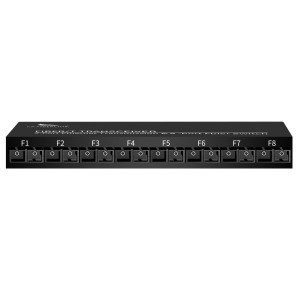
-300x300.jpg)
